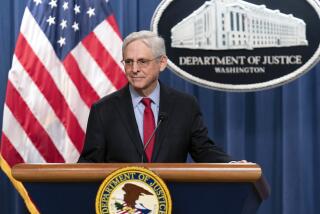How China unfairly bests the U.S.
- Share via
The American economy has been in trouble for more than a decade, and no amount of right-wing tax cuts or left-wing fiscal stimuli will solve the primary structural problem underpinning our slow growth and high unemployment. That problem is a massive, persistent trade deficit — most of it with China — that cuts the number of jobs created by nearly the number we need to keep America fully employed.
To understand why huge U.S. trade deficits represent the taproot of the nation’s economic woes, it’s crucial to understand that four factors drive our gross domestic product: consumption, business investment, government spending and net exports. This discussion focuses on net exports.
Net exports represent the difference between how much we export and import. A trade deficit means net exports are negative, and that directly reduces both the GDP growth rate and rate of job creation.
America’s trade deficit is costing us close to 1% of GDP growth a year at a loss of almost 1 million jobs annually. That’s millions of jobs we have failed to create over the last decade; and if we had those jobs now, we wouldn’t see continuing high unemployment numbers, padlocked houses under foreclosure and empty factories pushing up weeds.
It follows that if we want to get America back to work, we need to sharply reduce our trade deficit. As a statistical matter, that means sharply reducing our trade deficit with China.
Every business day, American consumers buy $1 billion more in Chinese exports than American manufacturers sell to China, and China alone accounts for about 70% of America’s trade deficit in goods, excluding oil imports. This “Chinese import dependence” has led a democratic America to owe the largest communist nation in the world more than $1 trillion, while China holds more than $3 trillion in foreign reserves, most of them in U.S. dollars.
To put these dollar reserves in perspective, that’s more than enough money for China to buy a controlling interest in every major company in the Dow Jones Industrial Average, including Alcoa, Caterpillar, Exxon Mobil and Wal-Mart, and still leave billions to spare.
So how can we eliminate, or at least drastically reduce, our trade deficit with China? For starters, we must puncture the myth that China’s main manufacturing edge is solely its cheap labor. Indeed, while low labor costs are a factor, when you carefully research the biggest source of China’s manufacturing advantage, it is actually a complex array of unfair trade practices, all of which are illegal under free-trade rules.
The most potent of China’s “weapons of job destruction” are an elaborate web of export subsidies; the blatant piracy of America’s technologies and trade secrets; the counterfeiting of valuable brand names like Nike and Chevy; a cleverly manipulated and grossly undervalued currency; and the forced transfer of the technology of any American company wishing to operate on Chinese soil or sell into the Chinese market.
Each of these unfair trade practices is expressly prohibited both by World Trade Organization rules as well as rules established by the U.S. government, e.g., the Treasury Department has sanctions against currency manipulation (which, alas, the Obama administration refuses to use against China despite campaign promises to do so).
In addition, there is the Chinese Communist Party’s incredibly shortsighted willingness to trade tremendous environmental damage and a surfeit of workplace deaths and injuries for a few more pennies of production cost advantage, all because of ultra-lax regulatory standards. For example, according to the World Health Organization, almost 700,000 Chinese citizens die annually from the effects of air pollution — that’s like losing everybody in Wyoming every year — while Chinese officials acknowledge more than 2,000 coal mining deaths annually, compared with fewer than 50 in the United States.
Make no mistake. All of these real economic weapons have led to the shutdown of thousands of American factories and turned millions of American workers into collateral damage, all under the false flag of so-called free trade.
The second myth we must expose if we are to ever reverse the job-killing trade deficits we now run with China is the idea that free trade always benefits both countries. That doesn’t hold true if one country cheats on the other. Instead, when a mercantilist China uses unfair trade practices to wage war on our manufacturing base, the American economy is the big loser.
Given America’s structural problem with China and absent constructive trade reform, our economic prospects can only dim further. The presidential candidate who grasps that essential truth, which is becoming increasingly understood by much of the electorate, will be the one who wins in 2012. We need someone who can lead this country to a trade relationship with China founded on the American ideals of free and fair trade rather than a set of mercantilist and socialist trade policies that employ the Chinese masses at the expense of American workers.
Peter Navarro is a business professor at UC Irvine, a CNBC contributor and the coauthor with Greg Autry of “Death by China: Confronting the Dragon — A Global Call to Action.”
More to Read
A cure for the common opinion
Get thought-provoking perspectives with our weekly newsletter.
You may occasionally receive promotional content from the Los Angeles Times.










